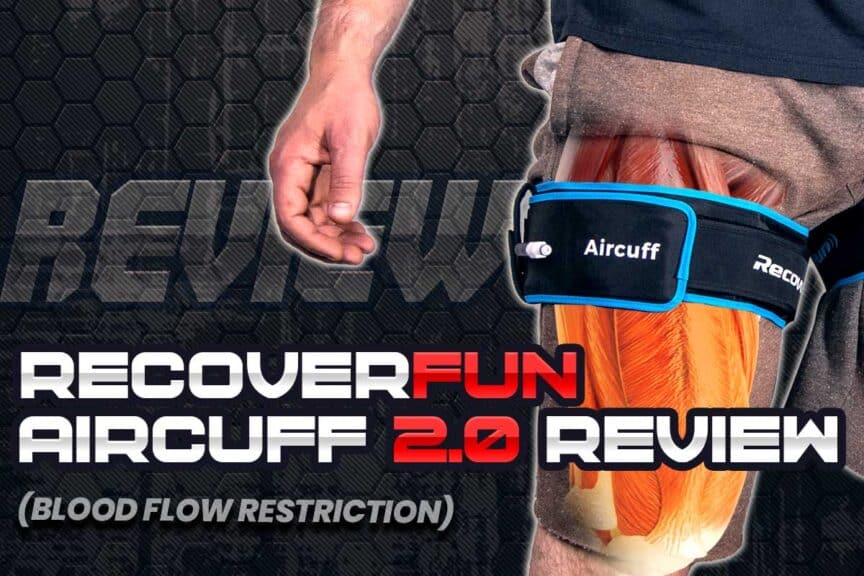Anyone who knows me knows that I use a lot of blood flow restriction (BFR) training in my clinical practice, and for a good reason: the science backs it up for producing muscle hypertrophy and strength increases while utilizing only 20-30% of a traditional strength training load.
With the science now making its rounds known to the general public, there’s currently no shortage of blood flow restriction cuffs on the market. And recently, I’ve got my hands on the new RecoverFun BFR AirCuff 2.0 system. I’ve been using it on myself and my patients, and after taking the time to play around with it, the time for a review has come.
In this article, I’ll go over the pertinent details of this system, along with my thoughts and experiences so far, so that by the end, you’ll know whether or not it’s a system worthy of your hard-earned dollars.

Disclaimer: RecoverFun sent me their AirCuff 2.0 system to use at no personal cost for me in exchange for an honest review of my thoughts on their product. All thoughts and opinions within this article are my own, and RecoverFun does not get any input as to what I say within this article, nor do they get to see this review before it is posted.
A small request: If you find this article to be helpful, or you appreciate any of the content on my site, please consider sharing it on social media and with your friends to help spread the word—it’s truly appreciated!
As we kick things off here, I’ll be comparing the RecoverFun BFR system to what I consider to be the gold standard in pneumatic BFR cuffs—the BStrong BFR System. The BStrong system, while not perfect, is the go-to system I’ve been using on myself, my patients within the clinic, and my athletes within the gym for a few years now.
It’s hard to know how good a product is without a reference to which it can be compared. So, I’m holding the RecoverFun 2.0 cuffs to some pretty high standards, but I will certainly be fair in my assessment.
Related article: In-Depth Product Review: BStrong BFR System (What You Must Know)
Strong Points: The RecoverFun System
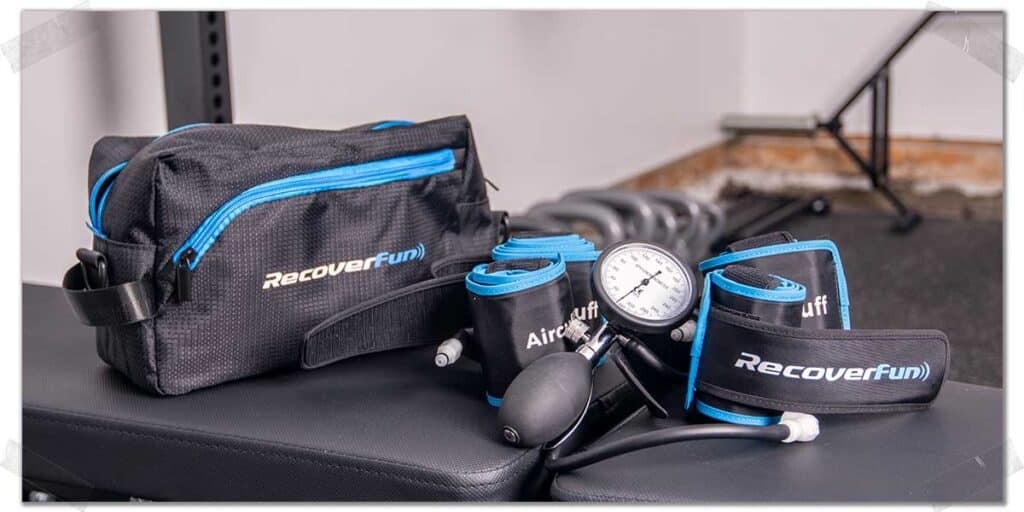
There’s a lot to like about these cuffs, both physically and cosmetically. Some of AirCuff’s strong points are just as good as the BStrong system, while they even rival or succeed them in other ways.
Below are a few quick thoughts on what I deem to be the more important factors for pneumatic BFR bands, of which the AirCuff 2.0 bands do a great job with.
Strong point 1: Material quality
RecoverFun has done a solid job here with constructing their cuffs from what feels like quality material. Now, only time will tell how well they hold up over the following year or so, but so far my colleagues nor I have had any issues or concerns with RecoverFun’s ability to hold up to repeated training sessions. With any luck, the RecoverFun materials will hold up to the tests of time.
For the record: I’ve been using my BStrong system for a few years now, and while the Velcro started tearing away after a few months of use, it has never gotten any worse and continues to perform well after hundreds of sessions. So, the bar has been set relatively high for RecoverFun.
Additionally, the folks at RecoverFun have made their new BFR system very easy to clean. As a clinician, this is truly appreciated since I need to repeatedly wipe down and clean any equipment I use with my patients once they’re done with their BFR session. No one wants to use cuffs that are soaked in sweat or grimy and dirty.
The soft carry case is very nice to have as I’m always carrying my cuffs from one place to another. I really appreciate the fact that a carry case comes with the purchase of a set of AirCuff bands, be it for the legs or the arms.
Strong point 2: One size fits all bands
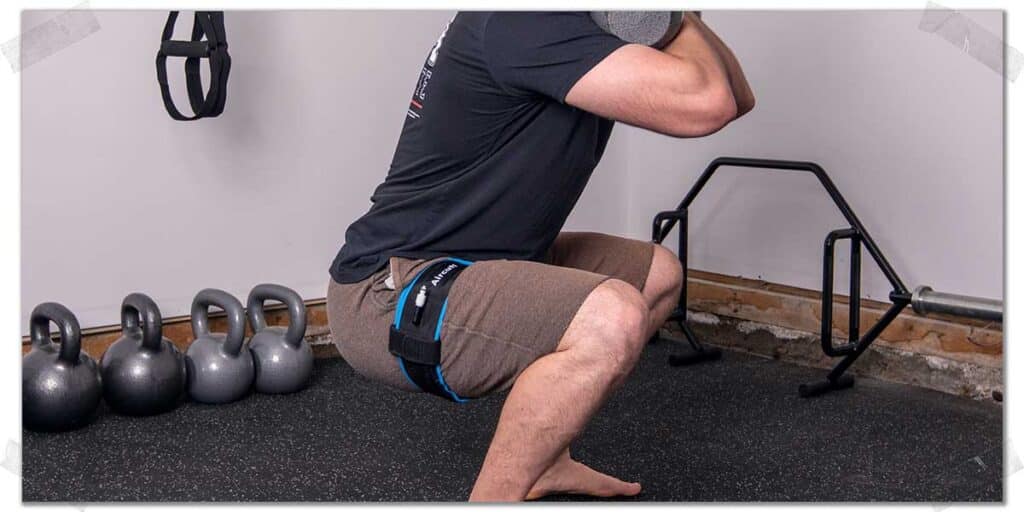
This is arguably the biggest win that the RecoverFun cuffs have over the BStrong system that I frequently use in the clinic with my patients. Unlike the BStrong system, which requires purchasing separate cuffs for small, medium, and large sizes (for arm and leg cuffs), the RecoverFun cuffs utilize a one-size-fits-all system, eliminating the need to purchase cuffs based on an individual’s limb size.
For an individual user, this may not be a big deal (it wouldn’t be if I used my cuffs merely on myself); however, since I implement BFR training into my clinical practice and gym-based sessions when working as a personal trainer, this becomes significant for me.
Related article: The BEST BFR Leg Exercises For Size And Strength (Backed By Science)
Not having to purchase additional-sized cuffs (which we’ve had to do for the BStrong system at our clinic) is a nice feature for practitioners such as myself who work with individuals of various sizes.
It also cuts down on the amount of equipment I have to pack up and carry around, so one-size-fits-all bands are a welcome feature for me.
Strong point 3: Self-contouring armbands
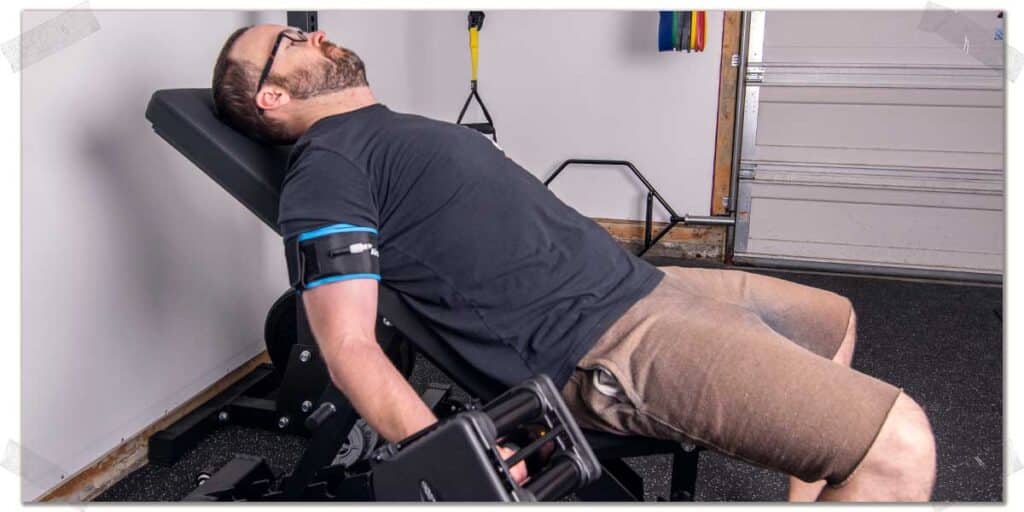
This was quite a nice touch by the folks at RecoverFun. Armbands can be tricky to put on since you essentially only have one hand to do so, so any added help is always a bonus.
The AirCuff armbands have a natural contour or hooking form factor to them, making it much more manageable to put the cuffs on if doing so by yourself. I have a feeling that without this feature, it would be rather challenging to wrap the armband around while ensuring it gets wrapped snugly and securely.
It’s worth noting that this self-contour isn’t found in the leg bands since it’s not needed; you’ll have both your hands free when putting them on, making it a much easier process.
The ratio: Cost to Build Quality
I never write my product reviews without first taking the time to put products to the test, both on myself and thereafter on my patients (I always start with myself before even thinking about using a product on my patients for potential safety concerns, ensuring optimal treatment, etc.).
“I have a feeling that as time goes on, I will find myself drifting more to the RecoverFun system due to its one-size-fits-all approach, comfort, and positive feedback I’ve received from my patients who have used them thus far.”
Build Quality
After having used the cuffs on myself and a handful of patients for a few weeks now, my initial reports are quite favorable—the cuffs seem to be holding up just fine, and neither my patients nor I have had any issues, or unforeseen complications arise from using the RecoverFun BFR system. Everything works as intended, and, at this time, I don’t have any hesitations with the pump or the bands themselves.
Comfort of the cuffs
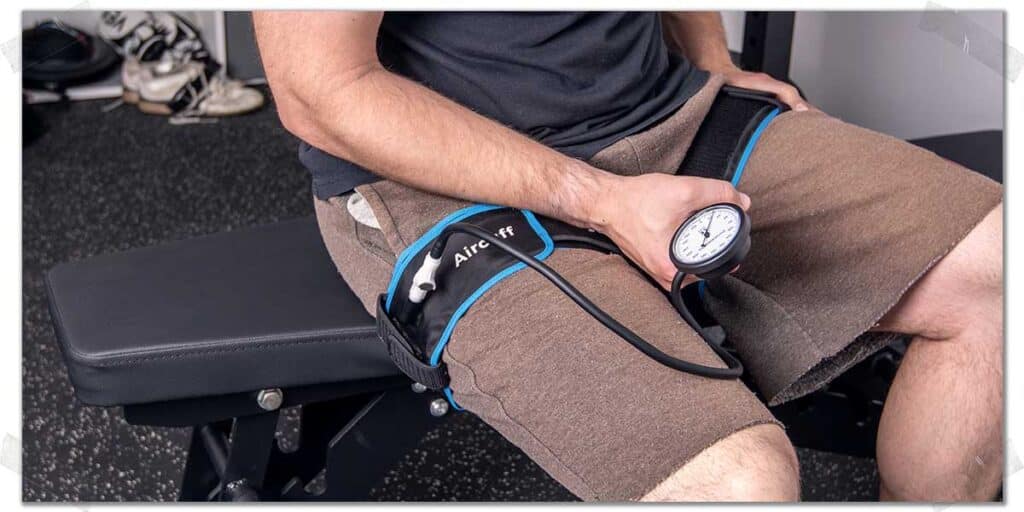
I’ve been pleasantly surprised with the comfort of these cuffs so far. They’re a bit wider than the BStrong cuffs, which I appreciate, as wider cuffs create greater restriction at lower pressures. I’ve always found the BStrong cuffs to be a little narrow for my liking, and while I find the BStrong cuffs quite comfortable to wear, I’ve always had to pump them to what feels like an excessively high pressure to feel I’m getting adequate restriction around my legs or arms.
The RecoverFun cuffs seem to fall in line with pressures that are more in line with scientific recommendations from peer-reviewed journal articles; I only have to pump the leg cuffs up to 150mmHg before feeling that I have a strong—but very tolerable restriction around my legs.
Pro tip: With the RecoverFun AriCuffs, if I pump the leg cuffs up any higher than 180mmHg, I start to cramp when exercising, which is a sign that there’s too much circumferential pressure around the extremities.
Cost of the system
While RecoverFun sent me a set of their cuffs at no charge, I’m still more than happy to give my thoughts on the price point of this system. I’m quite familiar with many BFR systems out there (pneumatic and real-time monitoring), so I’m confident with my thoughts on the appropriateness of a system’s pricing.
At the time of writing this review article, the pricing for this system (in US dollars) is:
- Leg cuffs: $129
- Arm cuffs: $109
- Full system (arms + legs): $179
Each purchase comes with a carrying bag, hand pump (sphygmomanometer), rubber replacement rings, and a user manual.
So, the fact that the RecoverFun system costs less than half of the equivalent BStrong system is quite outstanding. There are, however, two potential caveats that I need to mention with this:
Caveat 1: The BStrong system is designed by a team of renowned medical doctors and exercise physiologists and has been shown (via real-time ultrasound) to never fully occlude blood flow into or out of the extremities (a very nice safety feature). As such, this safety feature has always made it my go-to for clinic usage with my patients. Paying extra money for a set of bands that are designed by medical professionals might be justifiable for those who want the added reassurance.
Caveat 2: The BStrong system is fully waterproof and can be worn while swimming. I don’t know if this is the case with the RecoverFun system – their website mentions them being “waterproof,” but I don’t know if that means you can swim with them.
Regardless, based on using these cuffs for a few weeks now, I feel the RecoverFun cuffs are very fairly priced, which wins big bonus points in my books, as I have plenty of patients and athletes looking for an affordable yet durable BFR system for personal use.
Suggestions for Improvement
Overall, the RecoverFun BFR system adequately meets the needs of my patients and myself. I don’t have any suggestions for improvement regarding quality or functionality, which is good.
Rather, my only other grievances thus far (which are quite minimal overall) are in pertaining to the bands’ cosmetics.
Here’s what I’d like to see changed/improved for future iterations of these BFR cuffs:
Improvement 1: Different color armbands
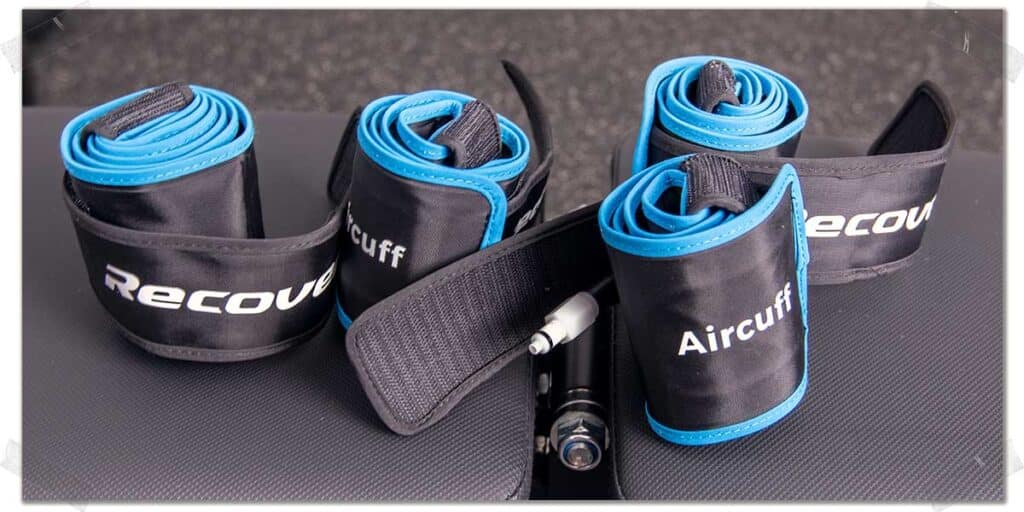
RecoverFun was nice enough to send me a set of their armbands along with their leg bands. Everything comes in a nice soft-shell carrying case, which I love, but having the armbands accented with the same blue color as the leg bands makes it a bit tricky to quickly and easily identify which type of cuff I’m grabbing when a pair from the bag.
The arm bands, when rolled up, although slightly shorter, look incredibly similar to the longer leg bands, so you really have to do a close look to know which are which.
To be clear, it’s a mild nuisance and nothing other than that. Still, there have been plenty of times in the clinic so far when I thought I grabbed two leg cuffs, only to realize I had inadvertently grabbed an armband and a leg band.
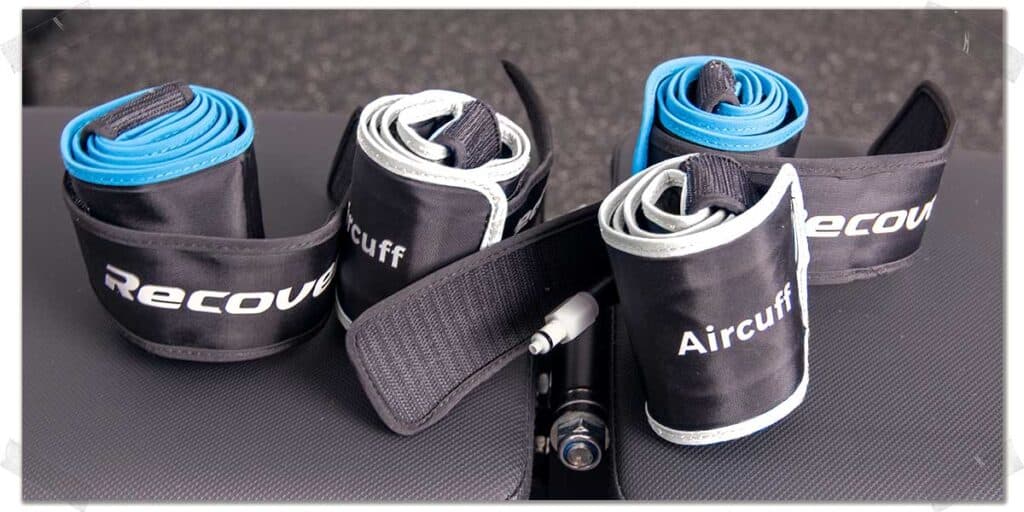
It would perhaps be easy enough to label the bands, or the folks at RecoverFun could even make the blue accent of the armbands a different shade of blue (or a different color altogether), making them easily identifiable when all are sitting together in the carry bag.
Either way, it’s not a dealbreaker, but something I would certainly modify or change if I were running the show. But, alas, I am merely a physical therapist.
Improvement 2: Removing the added attachment straps
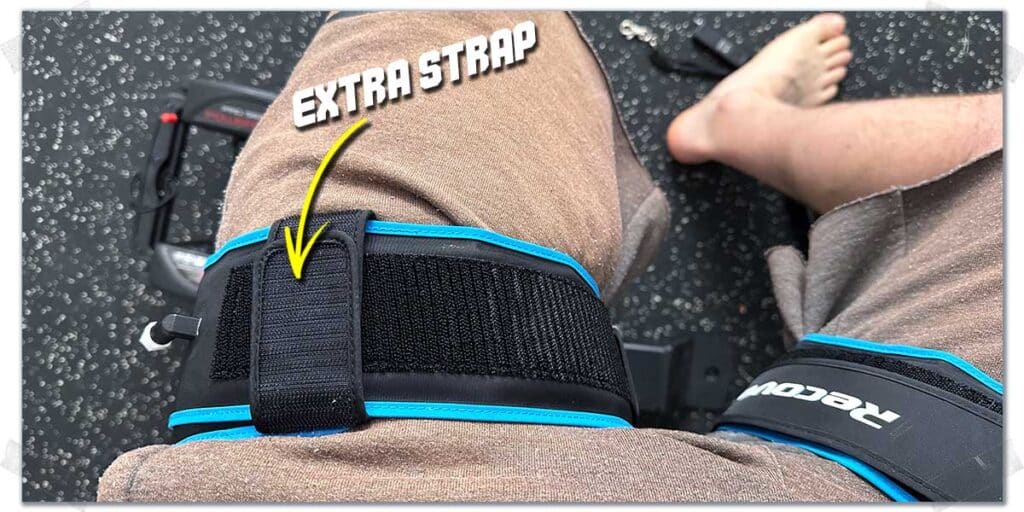
This critique of mine is merely just my personal tastes coming through, so again, this is nothing more than a minor, personal quibble.
Both the RecoverFun leg bands and arm bands come with an additional set of velcro straps or tabs that wrap around the bands, which helps them to stay securely rolled up. I have mixed feelings about these little straps; I see the purpose they serve—keeping the bands rolled up—but they also get in the way at times when wrapping the cuffs around the arms or legs.
This is most notable on the armbands, which gets tricky since you essentially only have one free arm and hand to pull the cuff around. Those little tabs can get in the way during the process, and it can be quite annoying.
It’s a very minor inconvenience, so perhaps I’m nit-picking here by mentioning it. I like the idea of them, but I find they get in the way somewhat frequently, making them more of a hindrance than a help. If they keep getting in the way, I might just cut them off since it will solve the problem of them getting in the way without negatively impacting the AirCuff’s function or performance.
It’s possible that most users won’t mind these little tabs at all, but I get kind of peculiar with these things, so we’ll see what I do with them as time goes on.
Final thoughts
I like these RecoverFun cuffs more than I initially thought I would. They certainly get the job done, all while being very reasonably priced. I’ll still be using my BStrong system with many of my patients and athletes. However, I have a feeling that as time goes on, I will find myself drifting more to the RecoverFun system due to its one-size-fits-all approach, comfort, and positive feedback I’ve received from my patients who have used them thus far.

Hi! I’m Jim Wittstrom, PT, DPT, CSCS, Pn1.
I am a physical therapist who is passionate about all things pertaining to strength & conditioning, human movement, injury prevention and rehabilitation. I created StrengthResurgence.com in order to help others become stronger and healthier. I also love helping aspiring students and therapists fulfill their dreams of becoming successful in school and within their clinical PT practice. Thanks for checking out my site!

